I snapped some pictures of various fern structures the other day and figured that I would do a little photo gallery showing the various stages of the fern life cycle. Unlike animals, the diploid stage (the one with two sets of chromosomes) in plants does not produce gametes. Rather, this stage produces spores via meiosis and is therefore known as the sporophyte (spore-producing plant). The sporophyte is the stage most familar to us, as seen in the following image.

The fern sporophyte produces leaves called fronds. On the back of the fronds of many species are often found little dots called sori (singular is sorus). To the naked eye they look like little brown spots like the ones below.

Even at this magnification the actual structure of a sorus is not clear. Zooming in a little further the surface begins to look a little rough.
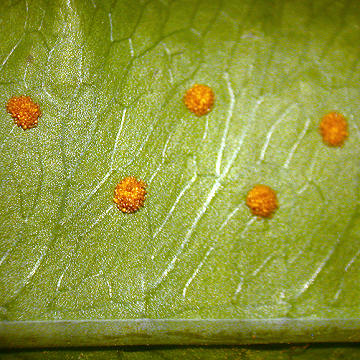
The reason for the rough appearance is the presence of the sporangia that make up the sori. The sporangia are not always visible because in some ferns they are covered by a structure called an indusium. In this particular species there are no indusia, so if the sori are viewed under a dissecting microscope and viewed at 3X magnification the sporangia become clearly visible.

One of my students described the appearance of the sporangia as bug-like. This is due to the row of large cells circling the outside of a sporangium. This is called the annulus and can be clearly seen if a few sporangia are scraped from the back of the frond and mounted with some water on a slide. The following image shows a sporangium viewed at 40X magnification.
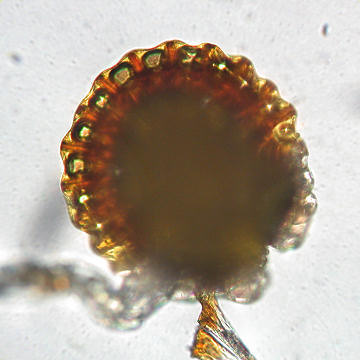
Everything seen up until now has been part of the sporophyte and would be diploid. Inside the sporangium is where meiosis takes place, and this process results in the production of haploid spores from diploid cells. The spores are greenish or brown with a warty surface and several can be found within each sporangium. The annulus on the outside of the sporangium shrinks or expands with changes in moisture in the environment and helps control opening and closing of the sporangium. Under the right conditions the sporangium will open and release spores into the air. The image below shows several spores that were mounted on a slide and viewed at 400X magnification.
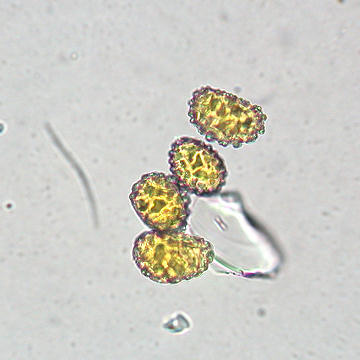
These spores can drift through the air until moist conditions set in, and then the spores will take on water and become heavier, at which point they will settle to the ground. If the environment is suitable the spores will germinate and develop into the haploid life stage known as the gametophyte. This progression from one life stage to another is known as alternation of generations and occurs in all plants. The fern gameotophyte is known as a prothallus and is often heart-shaped and green. They can vary in size but in some species may be up to a cm across. The following is an image of a fern prothallus viewed at 40X magnification after being stained and mounted on a slide.
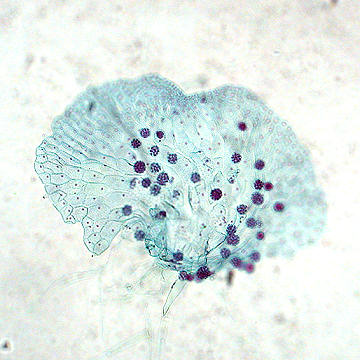
The little dots covering the surface of the prothallus are antheridia. Each antheridium is filled with sperm, the product of mitosis within those cells. Under moist conditions these sperm will be released to seek out eggs to fertilize. Eggs are sometimes produced on the same prothallus as the sperm, but in some species may occur on a seperate prothallus. Eggs are produced in specialized structures known as archegonia. Each prothallus can produce a single zygote that will develop into a new sporophyte. The zygote and subsequent sporophyte are diploid because they are the product of fertilization – the union of two haploid gametes (n + n = 2n). The developing sporophyte will appear as a short stem with a single leaf (shown at about 4X magnification as viewed under a dissecting microscope).
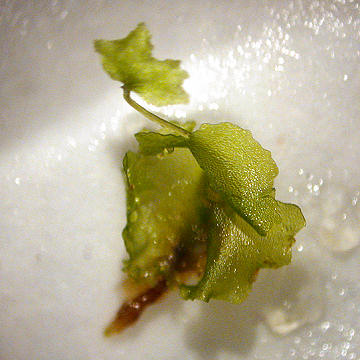
The sporophyte will be dependent on the gametophyte for a short time, after which the gametophyte will die and the sporophyte will become independent and develop into what we recognize as the adult fern.

Notice that no seeds are produced at any point in the life cycle. Ferns are known as seedless vascular plants because they have a free-living gametophyte and rely on spores for dispersal. The gametophyte is retained within the ovule of seeds plants (the ovule is what develops into the seed). Since ferns do not produce seeds, this makes growing them a bit more challenging, as it requires first sowing the spores and waiting for the gametophytes to develop, then providing a film of water in order for fertilization to occur. After that the process is similar to the handling of seedlings, although the young ferns may require a more humid environment until they mature.